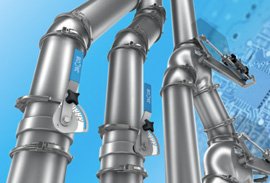When it comes to the food manufacturing and processing industry, it is extremely important that the right hygiene practices are used to ensure no cross-contamination takes place. Sanitation and cleaning are highly prized in the industry, which is a major reason why food grade pipes made of special stainless steel are so extensively used throughout the world when it comes to food processing.
The metal of choice
Although today, it is almost expected that a food processing plant would use stainless steel in its pipework systems, this wasn’t always the case. Prior to the creation of stainless steel around the 1910s, iron and cast iron were used in manufacturing and processing plants, which were both extremely heavy and would react with certain chemicals and leach by-products into the food being processed.
In 1913, Harry Brearly invented the first real stainless steel when he added 12.8% chromium to iron to produce a metal that was resistant to corrosion and rust. Even after its discovery, it didn’t become popular in the US and England until 1929, and even then, the Great Depression slowed its adoption. At first, the metal was used to create surgical tools and cutlery. As time passed, people started experimenting with making stainless steel alloys with different compositions, presenting different forms of steel with varying degrees of corrosion resistance, malleability and strength.
Today, the metal is used extensively across all kinds of applications, from the pipework used in food manufacturing and processing plants, the equipment used in commercial and residential kitchens, cutlery, medical and surgical equipment, in the automotive and aerospace industries as well as in architecture. There are roughly a hundred grades of stainless steel commercially available today, falling into four general groups: ferritic, martensitic, austenitic, and duplex.
But to be considered food-grade, stainless steel needs to meet certain requirements, like the ones below:
Characteristics of Food Grade Stainless Steel
- Composition:
Not all types of stainless steel are considered food grade. Typically, to be considered food-grade, the stainless steel needs to be formulated with a high chromium and nickel content, and low carbon content. It also needs to be bead blasted or micro-polished to remove the surface layer of steel, revealing a smooth, uniform surface that prevents bacteria from working its way through the microscopic flaws in the surface.
- Types:
The most common types of stainless steel that are considered food grade are the 316 grades, although the 200 series, 304 and 430 types can also be used for food processing and handling.
- Anti-corrosion:
Due to its high corrosion content, stainless steel is anti-corrosion. Through a process called “passivation”, a metal is treated or coated with a film that reduces its reactivity to chemicals. When iron is passivated with chromium, a passive film forms over the surface that prevents the iron from oxidising. Even if the chromium film is repeatedly exposed to water, or if the surface is damaged by tools, the film is able to repair itself by reacting with the oxygen present in our environment, protecting the iron underneath. This is what grants it its long-lasting durability.
- Temperature resistance:
Another very important quality for a metal to be considered food-grade stainless steel is its resistance to extreme temperatures. Because a food processing or manufacturing plant may consistently use variations in temperature, such as cold storage for meat and seafood processing facilities, it is essential for the equipment used to be resistant to fluctuations in heat. This is why food grade pipes are so popular in such facilities. The higher the chromium content of the stainless steel used, the higher its temperature resistance.
- Easy sanitisation:
Although often known as a bacteria-resistant material, it is not actually the stainless steel metal itself that is resistant to bacteria and germs, but the way it is prepared. By micro polishing or bead blasting the surface of the metal, any microscopic blemishes and flaws are removed, revealing a smooth, impeccable surface. With no grooves or cracks to settle into, bacteria and germs find it hard to survive on the surface. This flawless surface also allows for easy sanitisation, which is why the material is so popular in the food processing, manufacturing and handling industries.
- Durable:
Steel in itself is a highly durable material, able to withstand all kinds of conditions for centuries on end. It is also easily 100% recyclable, which makes it highly sustainable. Because stainless steel is resistant to corrosion and less likely to undergo wear and tear, it makes it even more durable, even requiring very little maintenance.
All of these characteristics combined explain why food grade pipework systems and equipment are so popular and are so extensively used in the food processing, manufacturing and handling industries.
He writes in several genres. Kevin and his wife, Julia, to whom he dedicates all of his published works, and their dog, Buddy, live in Melbourne, Australia.

